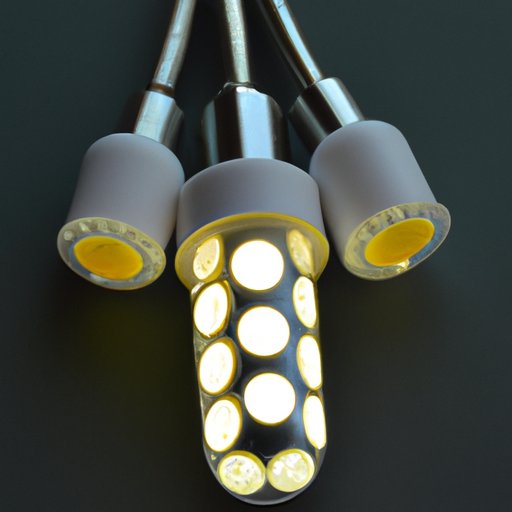Introduction
Light-emitting diodes (LEDs) are a type of semiconductor device that convert electrical energy into visible light. They are one of the most widely used types of lighting technology, and they are becoming increasingly popular due to their energy efficiency and long life. This article will explore the basics of how LEDs work, the different types of LEDs and their applications, and the advantages and disadvantages of using LED lighting.

Explaining the Basics of How LEDs Work
To understand how LEDs work, it is important to first understand what a diode is. A diode is a type of electronic component that allows electricity to flow in only one direction, from the anode to the cathode. The anode is the positive terminal of the diode, and the cathode is the negative terminal. When a voltage is applied across a diode, electrons flow from the anode to the cathode, creating a current. As the electrons move through the diode, some of them are converted into photons, which are particles of visible light.
The amount of light produced by a diode depends on the type of material used in the diode. Different materials produce different colors of light, and this is why there are different types of LEDs. Common types of LEDs include red, green, blue, and white.
Investigating the Different Types of LEDs and Their Applications
The most common applications for LEDs are in displays and indicators, such as those found on computers, televisions, and mobile phones. LEDs are also used in automotive lighting, such as brake lights, turn signals, and headlights. Additionally, LEDs are used in general lighting, such as in homes and offices.
The most common colors of LEDs are red, green, blue, and white. Red LEDs are used for indicators and displays, while green and blue LEDs are used for displays and decorative lighting. White LEDs are used for general lighting and are becoming increasingly popular due to their energy efficiency and long life.

Exploring the Advantages and Disadvantages of LEDs
LEDs have several advantages over other types of lighting technology. For starters, they are more energy efficient than traditional incandescent bulbs, and they last much longer, with some models lasting up to 50,000 hours or more. LEDs also produce very little heat, making them safer to use than other types of lighting. Additionally, they are available in a wide range of colors, allowing for creative lighting designs.
However, LEDs also have some drawbacks. One of the biggest disadvantages is cost. LEDs are more expensive than traditional bulbs, and they require specialized drivers and controllers to operate. Additionally, LEDs are not suitable for dimming, so they cannot be used in applications where dimming is required.
Comparing LEDs to Other Lighting Technologies
LEDs are significantly more efficient than traditional lighting technologies, such as incandescent and fluorescent bulbs. LEDs use about 75% less energy than incandescent bulbs and about 50% less energy than fluorescent bulbs. Additionally, LEDs produce less heat than other types of lighting, so they can be used in enclosed spaces without causing a fire hazard.
LEDs also have a much longer lifespan than other lighting technologies. Incandescent bulbs typically last about 1,000 hours, while fluorescent bulbs last about 10,000 hours. In comparison, LEDs can last up to 50,000 hours or more, depending on the type of LED and the application.

Examining the Energy Efficiency of LEDs
LEDs are more energy efficient than other lighting technologies because they produce more light per watt of electricity. This means that they use less energy to produce the same amount of light. Additionally, LEDs generate very little heat, so they do not require additional cooling systems, which further increases their energy efficiency.
There are several ways to make LEDs even more energy efficient. For starters, use LED bulbs with a lower wattage than traditional bulbs. Additionally, choose LED fixtures with built-in controls, such as dimmers or motion sensors, to reduce energy usage. Finally, make sure to use the correct wattage for the application to ensure maximum efficiency.
Exploring the Future of LED Technology
LED technology is constantly evolving and improving. New developments include white LEDs with higher color temperatures, which provide better illumination, and ultra-efficient LEDs, which consume even less energy than traditional LEDs. Additionally, researchers are exploring ways to use LEDs in new applications, such as medical devices and artificial intelligence.
The future of LED technology looks very promising. As the technology continues to improve, LEDs will become even more energy efficient and cost effective. Additionally, new applications for LEDs will continue to emerge, providing exciting opportunities for creative lighting solutions.
Conclusion
LEDs are a type of semiconductor device that convert electrical energy into visible light. They are becoming increasingly popular due to their energy efficiency and long life. This article explored the basics of how LEDs work, the different types of LEDs and their applications, and the advantages and disadvantages of using LED lighting. Additionally, it compared LEDs to other lighting technologies and examined the energy efficiency of LEDs. Finally, it looked at the future of LED technology and the potential applications for LEDs in the future.
(Note: Is this article not meeting your expectations? Do you have knowledge or insights to share? Unlock new opportunities and expand your reach by joining our authors team. Click Registration to join us and share your expertise with our readers.)
